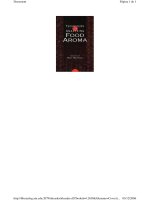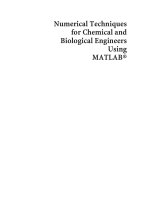61 Beamforming Techniques for Spatial Filtering
Bạn đang xem bản rút gọn của tài liệu. Xem và tải ngay bản đầy đủ của tài liệu tại đây (225.95 KB, 23 trang )
Barry Van Veen, et. Al. “Beamforming Techniques for Spatial Filtering.”
2000 CRC Press LLC. <>.
BeamformingTechniquesfor
SpatialFiltering
BarryVanVeen
UniversityofWisconsin
KevinM.Buckley
VillanovaUniversity
61.1Introduction
61.2BasicTerminologyandConcepts
BeamformingandSpatialFiltering
•
SecondOrderStatistics
•
BeamformerClassification
61.3DataIndependentBeamforming
ClassicalBeamforming
•
GeneralDataIndependentResponse
Design
61.4StatisticallyOptimumBeamforming
MultipleSidelobeCanceller
•
UseofaReferenceSignal
•
Maxi-
mizationofSignal-to-NoiseRatio
•
LinearlyConstrainedMin-
imumVarianceBeamforming
•
SignalCancellationinStatis-
ticallyOptimumBeamforming
61.5AdaptiveAlgorithmsforBeamforming
61.6InterferenceCancellationandPartiallyAdaptive
Beamforming
61.7Summary
61.8DefiningTerms
References
FurtherReading
61.1 Introduction
Systemsdesignedtoreceivespatiallypropagatingsignalsoftenencounterthepresenceofinterference
signals.Ifthedesiredsignalandinterferersoccupythesametemporalfrequencyband,thentemporal
filteringcannotbeusedtoseparatesignalfrominterference.However,desiredandinterferingsignals
oftenoriginatefromdifferentspatiallocations.Thisspatialseparationcanbeexploitedtoseparate
signalfrominterferenceusingaspatialfilteratthereceiver.
Abeamformerisaprocessorusedinconjunctionwithanarrayofsensorstoprovideaversatile
formofspatialfiltering.Thetermbeamformingderivesfromthefactthatearlyspatialfilterswere
designedtoformpencilbeams(seepolarplotinFig.61.5(c))inordertoreceiveasignalradiatingfrom
aspecificlocationandattenuatesignalsfromotherlocations.“Formingbeams”seemstoindicate
radiationofenergy;however,beamformingisapplicabletoeitherradiationorreceptionofenergy.
Inthissectionwediscussformationofbeamsforreception,providinganoverviewofbeamforming
fromasignalprocessingperspective.Dataindependent,statisticallyoptimum,adaptive,andpartially
adaptivebeamformingarediscussed.
c
1999byCRCPressLLC
Implementing a temporal filter requires processing of data collected over a temporal aperture.
Similarly, implementing a spatial filter requires processing of data collected over a spatial aperture.
A single sensor such as an antenna, sonar transducer, or microphone collects impinging energy over
a continuous aperture, providing spatial filtering by summing coherently waves that are in phase
across the aperture while destructively combining waves that are not. An array of sensors provides
a discrete sampling across its aperture. When the spatial sampling is discrete, the processor that
performs the spatial filtering is termed a beamformer. Typically a beamformer linearly combines
the spatially sampled time series from each sensor to obtain a scalar output time series in the same
manner that an FIR filter linearly combines temporally sampled data. Two principal advantages of
spatial sampling with an array of sensors are discussed below.
Spatial discrimination capability depends on the size of the spatial aperture; as the aperture in-
creases, discrimination improves. The absolute aperture size is not important, rather its size in
wavelengths is the critical parameter. A single physical antenna (continuous spatial aperture) capa-
ble of providing the requisite discrimination is often practical for high frequency signals because the
wavelength is short. However, when low frequency signals are of interest, an array of sensors can
often synthesize a much larger spatial aperture than that practical with a single physical antenna.
A second very significant advantage of using an array of sensors, relevant at any wavelength, is
the spatial filtering versatility offered by discrete sampling. In many application areas, it is necessary
to change the spatial filtering function in real time to maintain effective suppression of interfering
signals. This change is easily implemented in a discretely sampled system by changing the way in
which the beamformer linearly combines the sensor data. Changing the spatial filtering function of
a continuous aperture antenna is impractical.
This section begins with the definition of basic terminology, notation, and concepts. Succeeding
sections cover data-independent, statistically optimum, adaptive, and partially adaptive beamform-
ing. We then conclude with a summary.
Throughout this section we use methods and techniques from FIR filtering to provide insight
into various aspects of spatial filtering with beamformer. However, in some ways beamforming
differs significantly from FIR filtering. For example, in beamforming a source of energy has several
parameters that can be of interest: range, azimuth and elevation angles, polarization, and temporal
frequencycontent. Differentsignalsareoftenmutuallycorrelatedasaresultofmultipathpropagation.
The spatial sampling isoftennonuniform and multidimensional. Uncertainty mustoften be included
in characterization of individual sensor response and location, motivating development of robust
beamforming techniques. These differences indicate that beamforming represents a more general
problem than FIR filtering and, as a result, more general design procedures and processing structures
are common.
61.2 Basic Terminology and Concepts
In this section we introduce terminology and concepts employed throughout. We begin by defining
the beamforming operation and discussing spatial filtering. Next weintroduce second order statistics
of the array data, developing representations for the covariance of the data received at the array and
discussing distinctions between narrowband and broadband beamforming. Last, we define various
types of beamformers.
61.2.1 Beamforming and Spatial Filtering
Figure 61.1 depicts two beamformers. The first, which samples the propagating wave field in space,
is typically used for processing narrowband signals. The output at time k, y(k), is given by a linear
c
1999 by CRC Press LLC
combination of the data at the J sensors at time k :
y(k) =
J
l=1
w
∗
l
x
l
(k)
(61.1)
where ∗ represents complex conjugate. It is conventional to multiply the data by conjugates of the
weights to simplify notation. We assume throughout that the data and weights are complex since in
many applications a quadrature receiver is used at each sensor to generate in phase and quadrature (I
and Q) data. Each sensor is assumed to have any necessary receiver electronics and an A/D converter
if beamforming is performed digitally.
FIGURE 61.1: A beamformer forms a linear combination of the sensor outputs. In (a), sensor
outputs are multiplied by complex weights and summed. This beamformer is typically used with
narrowband signals. A common broadband beamformer is illustrated in (b).
The second beamformer in Fig. 61.1 samples the propagating wave field in both space and time
and is often used when signals of significant frequencyextent (broadband) areof interest. The output
in this case can be expressed as
y(k) =
J
l=1
K−1
p=0
w
∗
l,p
x
l
(k − p)
(61.2)
where K − 1 is the number of delays in each of the J sensor channels. If the signal at each sensor is
viewed as an input, then a beamformer represents a multi-input single output system.
It is convenient to develop notation that permits us to treat both beamformers in Fig. 61.1 simul-
taneously. Note that Eqs. (61.1) and (61.2) can be written as
y(k) = w
H
x(k)
(61.3)
byappropriatelydefiningaweightvector w anddatavectorx(k). Weuseloweranduppercaseboldface
to denote vector and matrix quantities, respectively, and let superscript H represent Hermitian
c
1999 by CRC Press LLC
(complex conjugate) transpose. Vectors are assumed to be column vectors. Assume that w and x(k)
are N dimensional; this implies that N = KJ when referring toEq. (61.2) and N = J when referring
to Eq. (61.1). Except for Section 61.5 on adaptive algorithms, we will drop the time index and assume
that its presence is understood throughout the remainder of the paper. Thus, Eq. (61.3)iswritten
as y = w
H
x. Many of the techniques described in this section are applicable to continuous time as
well as discrete time beamforming.
The frequency response of an FIR filter with tap weights w
∗
p
, 1 ≤ p ≤ J and a tap delay of T
seconds is given by
r(ω) =
J
p=1
w
∗
p
e
−jωT(p−1)
.
(61.4)
Alternatively
r(ω) = w
H
d(ω)
(61.5)
where w
H
=[w
∗
1
w
∗
2
...w
∗
J
] and d(ω) =[1 e
jωT
e
jω2T
...e
jω(J−1)T
]
H
. r(ω) represents the
response of the filter
1
to a complex sinusoid of frequency ω and d(ω) is a vector describing the phase
of the complex sinusoid at each tap in the FIR filter relative to the tap associated with w
1
.
Similarly, beamformer response is defined asthe amplitudeand phase presented to a complexplane
waveas a function oflocation andfrequency. Location is, ingeneral, athreedimensional quantity, but
often we are only concerned with one- or two-dimensional direction of arrival (DOA). Throughout
the remainder of the section we do not consider range. Figure 61.2 illustrates the manner in which
an array of sensors samples a spatially propagating signal. Assume that the signal is a complex plane
wave with DOA θ and frequency ω. For convenience let the phase be zero at the first sensor. This
implies x
1
(k) = e
jωk
and x
l
(k) = e
jω[k−
l
(θ)]
, 2 ≤ l ≤ J.
l
(θ) represents the time delay due to
propagation from the first to the lth sensor. Substitution into Eq. (61.2) results in the beamformer
output
y(k) = e
jωk
J
l=1
K−1
p=0
w
∗
l,p
e
−jω[
l
(θ)+p]
= e
jωk
r(θω)
(61.6)
where
1
(θ) = 0. r(θ,ω)is the beamformer response and can be expressed in vector form as
r(θ,ω) = w
H
d(θ, ω) .
(61.7)
The elements of d(θ, ω) correspond to the complex exponentials e
jω[
l
(θ)+p]
. In general it can be
expressed as
d(θ, ω) =[1 e
jωτ
2
(θ)
e
jωτ
3
(θ)
...e
jωτ
N
(θ)
]
H
.
(61.8)
where the τ
i
(θ), 2 ≤ i ≤ N are the time delays due to propagation and any tap delays from the
zero phase reference to the point at which the ith weight is applied. We refer to d(θ, ω) as the array
response vector. It is also known as the steering vector, direction vector, or array manifold vector.
Nonideal sensor characteristics can be incorporated into d(θ, ω) by multiplying each phase shift by
a function a
i
(θ, ω), which describes the associated sensor response as a function of frequency and
direction.
The beampattern is defined as the magnitude squared of r(θ,ω). Note that each weight in w affects
both the temporal and spatial response of the beamformer. Historically, use of FIR filters has been
viewed as providing frequency dependent weights in each channel. This interpretation is somewhat
1
An FIR filter is by definition linear, so an input sinusoid produces at the output a sinusoid of the same frequency. The
magnitude and argument of r(ω) are, respectively, the magnitude and phase responses.
c
1999 by CRC Press LLC
FIGURE 61.2: Anarray with attached delay lines providesa spatial/temporal sampling of propagating
sources. This figure illustrates this sampling of a signal propagating in plane waves from a source
located at DOA θ. With J sensors and K samples per sensor, at any instant in time the propagating
source signal is sampled at JK nonuniformly spaced points. T(θ), the time duration from the first
sample of the first sensor to the last sample of the last sensor, is termed the temporal aperture of
the observation of the source at θ. As notation suggests, temporal aperture will be a function of
DOA θ. Plane wave propagation implies that at any time k a propagating signal, received anywhere
on a planar front perpendicular to a line drawn from the source to a point on the plane, has equal
intensity. Propagation of the signal between two points in space is then characterized as pure delay.
In this figure,
l
(θ) represents the time delay due to plane wave propagation from the 1st (reference)
to the lth sensor.
incomplete since the coefficients in each filter also influence the spatial filtering characteristics of the
beamformer. As a multi-input single output system, the spatial and temporal filtering that occurs is
a result of mutual interaction between spatial and temporal sampling.
The correspondence between FIR filtering and beamforming is closest when the beamformer
operates at a single temporal frequency ω
o
and the array geometry is linear and equi-spaced as
illustrated in Fig. 61.3. Letting the sensor spacing be d, propagation velocity be c, and θ represent
DOA relative to broadside (perpendicular to the array), we have τ
i
(θ) = (i − 1)(d/c)sinθ. In this
case we identify the relationship between temporal frequency ω in d(ω) (FIR filter) and direction θ in
d(θ, ω
o
) (beamformer) as ω = ω
o
(d/c)sinθ. Thus, temporal frequency in an FIR filter corresponds
to the sine of direction in a narrowband linear equi-spaced beamformer. Complete interchange
of beamforming and FIR filtering methods is possible for this special case provided the mapping
between frequency and direction is accounted for.
The vector notation introduced in (61.3) suggests a vector space interpretation of beamforming.
This point of view is useful both in beamformer design and analysis. We use it here in consideration
c
1999 by CRC Press LLC
FIGURE 61.3: The analogy between an equi-spaced omni-directional narrowband line array and a
single-channel FIR filter is illustrated in this figure.
of spatial sampling and array geometry. The weight vector w and the array response vectors d(θ, ω)
are vectors in an N-dimensional vector space. The angles between w and d(θ, ω) determine the
response r(θ,ω). For example, if for some (θ, ω) the angle between w and d(θ, ω) 90
◦
(i.e., if w
is orthogonal to d(θ, ω)), then the response is zero. If the angle is close to 0
◦
, then the response
magnitude will be relatively large. The ability to discriminate between sources at different locations
and/or frequencies, say (θ
1
,ω
1
) and (θ
2
,ω
2
), is determined by the angle between their array response
vectors, d(θ
1
,ω
1
) and d(θ
2
,ω
2
).
The general effects of spatial sampling are similar to temporal sampling. Spatial aliasing corre-
sponds toan ambiguity in source locations. The implication is that sources at different locations have
the same array response vector, e.g., for narrowband sources d(θ
1
,ω
o
) and d(θ
2
,ω
o
). This can occur
if the sensors are spaced too far apart. If the sensors are too close together, spatial discrimination
suffers as a result of the smaller than necessary aperture; array response vectors are not well dis-
persed in the N dimensional vector space. Another type of ambiguity occurs with broadband signals
when a source at one location and frequency cannot be distinguished from a source at a different
location and frequency, i.e., d(θ
1
,ω
1
) = d(θ
2
,ω
2
). For example, this occurs in a linear equi-spaced
array whenever ω
1
sinθ
1
= ω
2
sinθ
2
. (The addition of temporal samples at one sensor prevents this
particular ambiguity.)
A primary focus of this section is on designing response via weight selection; however, (61.7)
indicates that response is also a function of array geometry (and sensor characteristics if the ideal
omnidirectional sensor model is invalid). In contrast with single channel filtering where A/D con-
verters provide a uniform sampling in time, there is no compelling reason to space sensors regularly.
Sensor locations provide additional degrees of freedom in designing a desired response and can be
selected so that over the range of (θ, ω) of interest the array response vectors are unambiguous and
well dispersed in the N dimensional vector space. Utilization of these degrees of freedom can be-
come very complicated due to the multidimensional nature of spatial sampling and the nonlinear
relationship between r(θ,ω)and sensor locations.
61.2.2 Second Order Statistics
Evaluation of beamformer performance usually involves power or variance, so the second order
statistics of the data play an important role. We assume the data received at the sensors are zero
mean throughout this section. The variance or expected power of the beamformer output is given
by E{|y|
2
}=w
H
E{xx
H
}w. If the data are wide sense stationary, then R
x
= E{xx
H
}, the data
c
1999 by CRC Press LLC
covariance matrix, is independent of time. Although we often encounter nonstationary data, the
wide sense stationary assumption is used in developing statistically optimal beamformers and in
evaluating steady state performance.
Supposex representssamples from a uniformly sampledtime series having a power spectral density
S(ω)and no energy outside of the spectral band [ω
a
,ω
b
]. R
x
can be expressed in terms of the power
spectral density of the data using the Fourier transform relationship as
R
x
=
1
2π
ω
b
ω
a
S(ω) d(ω) d
H
(ω) dω
(61.9)
with d(ω) as defined for (61.5). Now assume the array data x is due to a source located at direction
θ. In like manner to the time series case we can obtain the covariance matrix of the array data as
R
x
=
1
2π
ω
b
ω
a
S(ω) d(θ, ω) d
H
(θ, ω) dω
(61.10)
A source is said to be narrowband of frequency ω
o
if R
x
can be represented as the rank one outer
product
R
x
= σ
2
s
d(θ, ω
o
) d
H
(θ, ω
o
)
(61.11)
where σ
2
s
is the source variance or power.
The conditions under which a source can be considered narrowband depend on both the source
bandwidth and the time over which the source is observed. To illustrate this, consider observing
an amplitude modulated sinusoid or the output of a narrowband filter driven by white noise on an
oscilloscope. If the signal bandwidth is small relative to the center frequency (i.e., if it has small
fractional bandwidth), and the time intervals over which the signal is observed are short relative
to the inverse of the signal bandwidth, then each observed waveform has the shape of a sinusoid.
Note that as the observation time interval is increased, the bandwidth must decrease for the signal to
remain sinusoidal in appearance. It turns out, based on statistical arguments, that the observation
time bandwidth product (TBWP) is the fundamental parameter that determines whether a source
can be viewed as narrowband (see Buckley [2]).
An array provides an effective temporal aperture over which a source is observed. Figure 61.2
illustrates this temporal aperture T(θ)for a source arriving from direction θ. Clearly the TBWP is
dependent on the source DOA. An array is considered narrowband if the observation TBWP is much
less than one for all possible source directions.
Narrowband beamforming is conceptually simpler than broadband since one can ignore the tem-
poral frequency variable. This fact, coupled with interest in temporal frequency analysis for some
applications, has motivated implementation of broadband beamformers with a narrowband decom-
position structure, as illustrated in Fig. 61.4. The narrowband decomposition is often performed by
taking a discrete Fourier transform (DFT) of the data in each sensor channel using an FFT algorithm.
The data across the array at each frequency of interest are processed by their own beamformer. This
is usually termed frequency domain beamforming. The frequency domain beamformer outputs can
be made equivalent to the DFT of the broadband beamformer output depicted in Fig. 61.1(b) with
proper selection of beamformer weights and careful data partitioning.
61.2.3 Beamformer Classification
Beamformers canbe classified as either dataindependent or statistically optimum, depending on how
the weights are chosen. The weights in a data independent beamformer do not depend on the array
data and are chosen to present a specifiedresponse for allsignal/interference scenarios. The weights in
a statistically optimum beamformer are chosen based on the statistics of the array data to “optimize”
c
1999 by CRC Press LLC
FIGURE 61.4: Beamforming is sometimes performed in the frequency domain when broadband
signals are of interest. This figure illustrates transformation of the data at each sensor into the
frequency domain. Weighted combinations of data at each frequency (bin) are performed. An
inverse discrete Fourier transform produces the output time series.
the array response. In general, the statistically optimum beamformer places nulls in the directions
of interfering sources in an attempt to maximize the signal-to-noise ratio at the beamformer output.
A comparison between data independent and statistically optimum beamformers is illustrated in
Fig. 61.5.
The next four sections cover data independent, statistically optimum, adaptive, and partially adap-
tive beamforming. Data independent beamformer design techniques are often used in statistically
optimum beamforming (e.g., constraint design in linearly constrained minimum variance beam-
forming). The statistics of the array data are not usually known and may change over time so
adaptive algorithms are typically employed to determine the weights. The adaptive algorithm is de-
signed so the beamformer response converges to a statistically optimum solution. Partially adaptive
beamformers reduce the adaptive algorithm computational load at the expense of a loss (designed to
be small) in statistical optimality.
61.3 Data Independent Beamforming
The weights in a data independent beamformer are designed so the beamformer response approx-
imates a desired response independent of the array data or data statistics. This design objective —
approximating a desiredresponse —is thesame asthat forclassical FIR filter design (see, for example,
Parks and Burrus [8]). We shall exploit the analogies between beamforming and FIR filtering where
possible in developing an understanding of the design problem. We also discuss aspects of the design
problem specific to beamforming.
The first part of this section discusses forming beams in a classical sense, i.e., approximating
a desired response of unity at a point of direction and zero elsewhere. Methods for designing
beamformers having more general forms of desired response are presented in the second part.
61.3.1 Classical Beamforming
Consider the problem of separating a single complex frequency component from other frequency
components using the J tap FIR filter illustrated in Fig. 61.3. If frequency ω
o
is of interest, then the
c
1999 by CRC Press LLC









